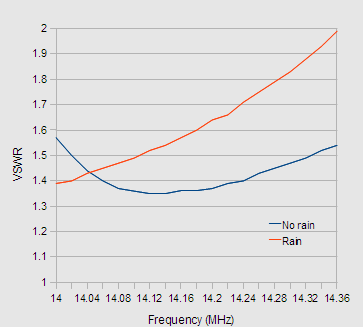The effects of rain

From time to time, Hexbeam users report that their VSWR appears to rise after a period of rain. I have not noticed the effect myself (despite living in UK!) and had not given the matter much thought until Leo K4KIO pointed me in the direction of an Antennex article written by YU1AW in which he attempted to model the effects of rain on VHF antennas. YU1AW assumed that the water would behave as a uniform dielectric surrounding the antenna conductors, and he modelled the effect the dielectric would produce on antenna performance. Although some of YU1AW's assumed dielectric parameters for the rain are open to challenge, the underlying principles might well explain the observed shifts in Hexbeam VSWR.
Adding a dielectric to a conductor decreases its velocity factor - that's the reason an antenna constructed from insulated wire has slightly different dimensions to one constructed from bare copper. So if YU1AW is right, we would expect rain to shift an antenna's tuning lower in frequency. However, it's not something that seems to affect other antennas significantly, so the question arises whether the Hexbeam is in some way more susceptible.
I modelled a Hexbeam using YU1AW's assumed dielectric properties for the rain; the results were interesting - the antenna's tuning shifted sufficiently low in frequency that it would likely cause a quite noticeable change in the VSWR. Unfortunately, EZNEC does not allow us to model the effects of both wire insulation and rain together, but I estimate that the detuning effect might typically be around 220kHz on 20m.
The effect that 220kHz shift would have on VSWR has is shown in the chart; the worst-case VSWR has risen from 1.54:1 to 1.98:1, and at the frequency where the VSWR was a minimum, it has risen from 1.35:1 to 1.55:1.
Unpicking the reasons why the Hexbeam appears more susceptible than some other antennas, there appear to be two factors in play:
- Firstly, the detuning effect of the dielectric is much more pronounced on a small-diameter conductor than on a large one - 4 times the frequency shift for #14 wire compared to 0.5" tubing; so we would expect wire antennas such as Moxons, Cubical Quads, and Hexbeams to suffer more than antennas constructed from aluminium tubing, like most Yagis.
- Secondly, the effect on VSWR of any given shift in tuning is more pronounced with an antenna that is inherently narrow-band than one which is broadband. Although we refer to the "broadband" version of the Hexbeam, it is still relatively narrow-band compared to something like a Cubical Quad. By extension, we might expect the Classic version of the Hexbeam to be more susceptible than the broadband version - something which modelling results support.
Put simply, the Hexbeam suffers a “double whammy” by virtue of being constructed from wire, and by having a size and shape which make it inherently narrow-band.
All of the above is speculation, but to date it's the most convincing explanation I have found for the observations reported by some users.